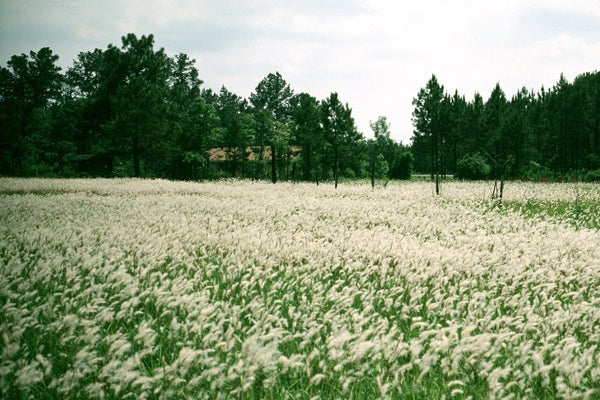
By Patrick Cook | Regional Extension Agent
Invasive plants, non-native plants that outcompete desirable vegetation, have been a problem in Chilton County for decades. Plants such as kudzu and Chinese privet have long been loathed for the problems they cause. However, there is now a plant invading the county that has the potential to wreak havoc on a scale never before seen.
Its name is cogongrass, and it poses a serious threat to our farms, forests, wildlife and even public safety. It spreads by windblown seed and rhizomes (underground stems similar to roots). The seed can be blown for more than 15 miles. The rhizomes have pointed tips so sharp they can pierce the roots of other plants thereby killing them. The grass also releases chemicals into the soil that inhibit the growth of other plants.
When the grass invades open areas such as fields and pastures, it quickly overtakes the site, rendering it useless for livestock production and wildlife because the plant is low in nutritive value, and the leaves have serrated edges that cut the tongues of grazing animals.
To make matters worse, cogongrass actually promotes wildfire. Its structure and chemical composition make it very combustible, and it burns hotter and more intensely than other plants. Even our most fire-resistant tree, longleaf pine, cannot tolerate cogongrass fires. Following a fire, the rhizomes sprout and the plant is able to spread more rapidly in the burned area now devoid of trees. Successive fires turn a forest into a sea of cogongrass. The increased number of wildfires threatens people and property. The thick smoke produced from cogongrass fires often settles on highways resulting in automobile accidents.
Cogongrass is native to Asia and was first introduced into the U.S. in 1911 at the port of Mobile from packing material that contained its seeds. Like most invasive plants, it went through a lag period before becoming an aggressive invader.
It is now spreading rapidly and has made its way into the county. Brian Smith, Forestry Commission forester serving Chilton County, stated “Cogongrass was first discovered here four years ago. This is not to say it was not here before, it most likely was, it just grew undetected.”
He also added, “We are doing the best we can to identify it on public land such as rights-of-way, but the majority of land is owned by private individuals. We strongly encourage them to learn how to identify cogongrass so we can help them eradicate it.”
To stave off the potentially disastrous consequences of a full-blown infestation, landowners and other residents need to be proactive and vigilant. Early detection of an infestation is critical for eradication. It is very difficult to control. Repeated treatments of herbicide for up to three years are required.
If left unchecked, the infestation can reach a point at which control becomes cost-prohibitive. The best time to spot infestations is right now in early spring. Cogongrass blooms earlier than other grasses, usually in late March and continuing into June.
At this time of year, the blooming infestations stand out, contrasting well with surrounding vegetation. The blooms occur on a spike and the seeds are light and fluffy, like dandelion seeds.
Infestations begin as small, dense, and circular patches. A good distinguishing feature of the leaves is a central vein that is off-center, especially near the base of the leaf.
If you find a patch of cogongrass, exercise caution. Do not mow through or near the area that has cogongrass, especially if it is flowering, as this may aid in dispersing the seeds. Do not disk, grade, or do any other soil work in or near the area.
Rhizome fragments can stick to equipment and be carried to other areas where the equipment is used. Contact the Forestry Commission office (205-755-3042) or the County Extension office (205-280-6268) for control recommendations and help with identification. More information can also be found at www.aces.edu, www.forestry.alabama.gov, and www.cogongrass.org.
